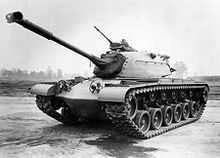Medium tank was a classification of tanks, primarily used during World War II. The medium tank, as the name suggests, represented a compromise in features between the reconnaissance and mobility oriented light tanks and the armor and armament oriented heavy tanks. The most widely produced, cost effective and successful tanks of World War II (the Soviet T-34, the American Sherman tank and the German Panzer IV) were all medium tank designs, and the success of the concept would later lead to the development of the main battle tank (which sought to incorporate the best aspects of all three tank types).
History
The first tanks to carry the name Medium appeared in the First World War with the British Medium Mark A "Whippet". It was smaller and lighter than the British heavy tanks and only carried machine guns.
The medium tank doctrine came into use in the interwar period. Its existence outlasted the super-heavy tank and heavy tank but eventually was eclipsed by the main battle tank.
World wars

Sherman medium tank from World War II, the workhorse of U.S. armoured forces
Medium tanks of the interwar period included the British Vickers Medium Mark II and the Soviet multi-turreted T-28.
In the period leading up to World War II, the British stopped using the term Medium for their tanks as the new philosophy of Cruiser tank and Infantry tank which defined tanks by the role rather than size came into use.
There were medium tanks that focused on anti-infantry capabilities (such as in World War II: the Panzer IV short-barrel, and the M4 Sherman), and medium tanks which were more focused on the anti-tank role, mounting high-velocity tank guns. The French cavalry tanks (Chars de Cavalerie) focused on speed in addition to power and protection of the other designs. They were similar to what other countries called medium tanks.
When Soviet tank designers were preparing a successor to the BT tank series, they combined its excellent mobility with thick, sloped armour and the unprecedented firepower of a 76 mm high-velocity gun. The result was the T-34 medium tank, whose superb capabilities shocked the German Wehrmacht when it invaded the Soviet Union. The lessons of Blitzkrieg, first employed by the Germans and eventually adopted by other nations, found their best expression in formations of mutually-supporting medium tanks and motorised infantry. The traditional view of infantry and cavalry tank roles was rendered obsolete.
Both the Soviet Union and the United States benefited from their ability to manufacture a well-balanced medium tank in very large numbers - around 57,000 T-34s and 49,000 M4 Sherman tanks were built during the war period.
Cold War
During and after the war, the roles of light tanks were gradually taken over by less-expensive armoured cars and specialised reconnaissance vehicles. Heavy tanks, having shown their limitations in World War II, experienced a limited arms race of progressively more heavily armed and armoured designs, but these too were eventually phased out in favour of increasingly capable and flexible medium tanks. Simpler and more economical self-propelled guns, and later anti-tank guided missiles, came to fulfill fire-support and anti-tank roles, allowing tanks to become more specialised for mobile warfare.
Role
Medium tanks are simply neither the heaviest nor lightest in weight, and many of the designs had successful balance of firepower, mobility, protection, and endurance, and could often be adapted to a variety of roles. In particular, up-armored variants of the M4 Sherman functioned much like heavy tanks.
See also
References
|
|---|
| | | | British | |
|---|
| | French | |
|---|
| | German | |
|---|
| | Austro-Hungarian | |
|---|
| | Italian | |
|---|
| | American | |
|---|
| | Russian | |
|---|
| Italics — experimental prototypes; * concept only
|
|
External links


